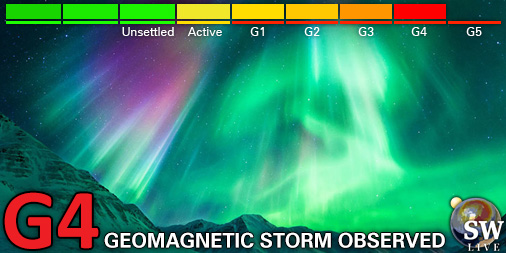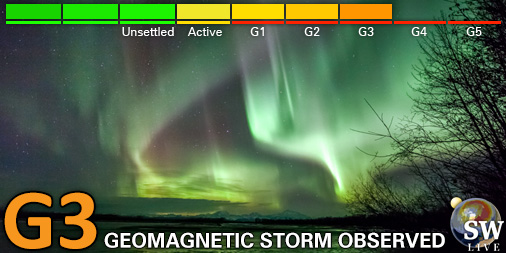Viewing archive of Tuesday, 21 October 2003
Solar activity report
Any mentioned solar flare in this report has a scaling factor applied by the Space Weather Prediction Center (SWPC). Because of the SWPC scaling factor, solar flares are reported as 42% smaller than for the science quality data. The scaling factor has been removed from our archived solar flare data to reflect the true physical units.
Report of Solar-Geophysical Activity 2003 Oct 21 2200 UTCPrepared by the NOAA © SWPC and processed by SpaceWeatherLive.com
Joint USAF/NOAA Report of Solar and Geophysical Activity
SDF Number 294 Issued at 2200Z on 21 Oct 2003IA. Analysis of Solar Active Regions and Activity from 20-2100Z to 21-2100Z
Solar activity has been moderate. There has been a
steady series of C-class flares and a single M1.0 at 21/0827 UTC.
Region 484 (N05E26) continues to grow, but at a lesser rate than
yesterday. The region is now 1650 millionths with at least a 50%
increase in magnetic intensity. A region just beyond the East limb,
generated a strong CME at approximately 21/0300 UTC, but does not
appear to be Earth-directed.
IB. Solar Activity Forecast
Solar activity is expected to remain
moderate. Region 484, and the new Region approaching the East limb,
are a combined threat to continue to generate C-class activity, with
an occasional M-class flare. There is a slight chance for an
isolated X-class event, and an even lesser chance for a
proton-producing flare. By day three, Region 484 will near central
meridian, and become a slightly higher threat for producing a flare
event which could generate protons at near-Earth.
IIA. Geophysical Activity Summary 20-2100Z to 21-2100Z
The geomagnetic field has been at active to minor storm levels. A
favorably positioned coronal hole is supporting a high-speed solar
wind stream, which is in turn supporting elevated magnetic activity
at Earth. The greater than 2 MeV electron flux at geosynchronous
orbit reached high levels today.
IIB. Geophysical Activity Forecast
The geomagnetic field is
expected to be at active to minor storm levels for the next three
days. The coronal hole will proceed out of geoeffective range
around the second day, but a faint shock associated with a CME which
occurred on the 19th should lightly impact Earth, once again
elevating magnetic activity on day three.
III. Event Probabilities 22 Oct to 24 Oct
| Class M | 70% | 70% | 70% |
| Class X | 15% | 15% | 15% |
| Proton | 10% | 10% | 15% |
| PCAF | green | ||
IV. Penticton 10.7 cm Flux
Observed 21 Oct 152 Predicted 22 Oct-24 Oct 150/155/160 90 Day Mean 21 Oct 114
V. Geomagnetic A Indices
Observed Afr/Ap 20 Oct 020/030 Estimated Afr/Ap 21 Oct 028/030 Predicted Afr/Ap 22 Oct-24 Oct 020/025-020/020-025/020
VI. Geomagnetic Activity Probabilities 22 Oct to 24 Oct
| A. Middle Latitudes | |||
|---|---|---|---|
| Active | 35% | 35% | 30% |
| Minor storm | 30% | 30% | 35% |
| Major-severe storm | 10% | 10% | 15% |
| B. High Latitudes | |||
|---|---|---|---|
| Active | 25% | 25% | 25% |
| Minor storm | 35% | 30% | 35% |
| Major-severe storm | 15% | 10% | 15% |
All times in UTC
Latest news
Latest forum messages
Coronal holes 512025/04/12-13 Filament CMEs 2025/04/16 G3 Watch 472Filaments and prominences 67AR4064 9Incoming & Unnumbered Active Regions 1742
More topicsSupport SpaceWeatherLive.com!
A lot of people come to SpaceWeatherLive to follow the Sun's activity or if there is aurora to be seen, but with more traffic comes higher server costs. Consider a donation if you enjoy SpaceWeatherLive so we can keep the website online!

Latest alerts
Wednesday, 16 April 2025
21:45 UTC - Geomagnetic activity
Minor G1 geomagnetic storm (Kp5) Threshold Reached: 21:36 UTC
21:00 UTC - Geomagnetic activity
Severe G4 geomagnetic storm (Kp8) Threshold Reached: 20:55 UTC
19:45 UTC - Geomagnetic activity
Strong G3 geomagnetic storm (Kp7) Threshold Reached: 19:25 UTC
19:00 UTC - Geomagnetic activity
Moderate G2 geomagnetic storm (Kp6) Threshold Reached: 18:38 UTC
18:45 UTC - Geomagnetic activity
Minor G1 geomagnetic storm (Kp5) Threshold Reached: 18:28 UTC
Space weather facts
| Last X-flare | 2025/03/28 | X1.1 |
| Last M-flare | 2025/04/15 | M1.2 |
| Last geomagnetic storm | 2025/04/16 | Kp8- (G4) |
| Spotless days | |
|---|---|
| Last spotless day | 2022/06/08 |
| Monthly mean Sunspot Number | |
|---|---|
| March 2025 | 134.2 -20.4 |
| April 2025 | 120.7 -13.5 |
| Last 30 days | 120.8 -19.6 |







